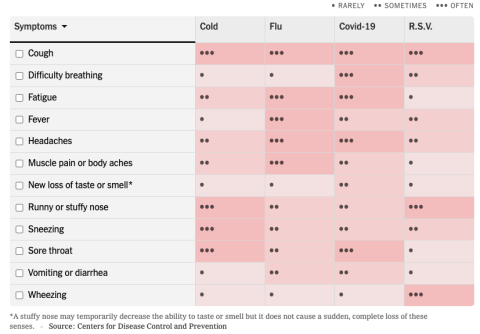Covid-19, Flu, or RSV or a Cold?

Three different viruses are sending children and adults to their doctor or urgent care across the United States this winter. Not only is the coronavirus (COVID-19) making a comeback with new variants, influenza (Flu) and the respiratory syncytial virus (RSV) are also spreading earlier than usual and at record rates.
Most people who avoided the flu and other infections like R.S.V. for the past few years took steps to slow the spread of Covid, which also slowed the spread of other viruses. As a result, more people are vulnerable to common winter viruses now that much of the country has set aside masks and social distancing and is traveling and gathering indoors more. And you can get really sick, perhaps more so than you would have normally, because your immune system really hasn’t been challenged as much recently.
Symptoms
Flu, Covid and R.S.V. have symptoms that overlap — and also can look quite similar to those of the common cold, which is caused by a variety of viruses. You can develop a cough, fever, headache or runny or stuffy nose with any respiratory virus. But one way to differentiate among viral infections is to monitor how quickly your symptoms ramp up.
- Symptoms of the flu come on quickly — often just one day after exposure to someone who was sick — and can be felt all over the body.
- With colds, symptoms may take two or three days to appear and are much milder.
- Covid and R.S.V. have even longer incubation periods. It can take an average of five days from exposure to the coronavirus to the development of early Covid-19 symptoms, though newer variants may result in an active infection as soon as three days after exposure.
- R.S.V. takes about four to six days.
- With Covid and R.S.V., symptoms also build slowly: You may start out feeling sniffly, and then develop a cough or a headache the next day and a fever the next.
- Adults afflicted with the flu are likely to experience very high fevers, up to 103 or 104 degrees but fevers rarely accompany colds, particularly in adults. And those with Covid-19 and R.S.V. experience mild fevers or none at all.
Your location matters. Looking at community transmission rates in your area is another way to determine which virus you might have. You can still check the Centers for Disease Control and Prevention’s Covid-19 map or the Connecticut Surveillance Dashboard in addition to relying on local news and social networks for a sense of whether members of your community are sick.
Testing is the only definitive way to know: Get Four Free At-Home COVID-19 Tests go to www.Covidtests.gov or get a PCR test done https://testinglocator.cdc.gov/
What to do if you are sick
- Stay home – for at least 5 days or until symptoms subside and there is no fever for at least 24 hours without fever reducing medications.
- Monitor symptoms and follow healthcare provider instructions.
Rest, drink fluids, and use over-the-counter medicines for fever. - If you feel you need antivirals – call your doctor or go to urgent care. You need to start the medication in the first 2 days of illness for it to be effective. Stay home and separate from others.
- Improve ventilation (air flow) at home to help prevent COVID-19 from spreading to other people.
- Practice every day hygiene and cleaning and avoid sharing personal household items.
• Wash your hands often.
• Cover coughs and sneezes. - Wear a high-quality mask or respirator when around other people.
• Wear a mask with the best fit, protection, and comfort.
If you are caring for someone with COVID-19:
• Follow everyday preventative actions.
• Wear a high-quality mask when you must be around them.
• Learn what to do after being exposed to COVID-19.
